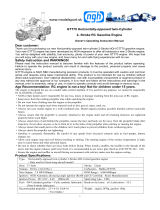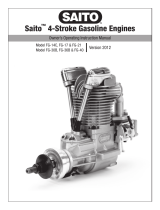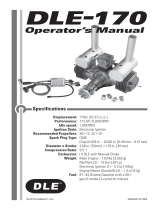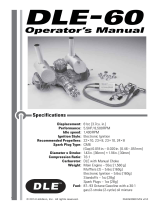
Adjust Carburetor:
When the engine running, you want to adjust the carburetor, please adjust it based on factory Settings:
In the process of adjusting the carburetor, please use a high-quality tachometer to determine your adjusted results, the
tachometer you need to buy one.
First adjust the high speed needle: Engine run time will be turned on at full throttle position, adjust the high needle and
watch the change of the tachometer, make the engine rpm reach the max per minute. Engine work in a stable high speed
(please note: do not let the engine run boundary for a long time, this is a big damage for engine). Adjust the idle speed
needle: The throttle return to the idle position, adjust the idle speed needle and watch the change of the tachometer. Let
the engine run in a stable state of idle speed (Advice 19x8 wooden propeller idle speed at 1800rpm).
When necessary and idle mixture adjustment screw joint adjustments to ensure the engine idle speed stability, smooth
acceleration; If the engine is idling start difficult (Exclude CDI ignition power shortage, excessive fuel combustion
chamber, spark plug problems and so on). This shows that air-fuel ratio (A/F) is low at idling, please adjust idle mixture
adjustment screw, increase air ratio, or adjust idling needle to reduce the amount of fuel, A/F ratio to achieve
appropriate proportion. ( Tip: The larger engine propeller, the more perfect lower idle speed you will get. )
When the engine high speed and idle speed adjustment is completed, try to run the engine acceleration performance.
First let the engine to run 10 seconds at idling and the quickly move the throttle control arm at full throttle position,
there will be the following three situations:
A. Engine speed is responsive and smooth transition to the highest speed, instructions for the adjustment of the engine is
very good.
B. Engine acceleration has a cough performance, gradually transition to the highest speed, illustrate the idle speed
needle set relatively rich oil, the idle speed needle to make a small adjustment (clockwise rotation), and then try again,
try to accelerate the reaction constant adjustment until the engine reaches your request.
C. Rapid throttle when the engine suddenly stopped running, this shows that the idle speed needle set relatively lean oil,
the idle speed needle to make a small adjustment (anticlockwise rotation), and then try again, try to accelerate the
reaction constant adjustment until the engine reaches your request.
Lubricated tube and Pulse tube connection:
Please according to as shown in FIG. 2 motioned connect, maintain the proper length of the tube, cut off the excess part.
The Fuel Tank Connecting:
As shown in figure
Fuel tank connection Valve clearance adjustment
Valve clearance Adjustment:
After approximately 2 hours flight, valve clearance adjustment may be necessary. Before adjusting valve clearance,
should check valve body to move freely, no clamping stagnation phenomenon. Due to the thermal expansion of metal m
aterials, valve clearance adjustment should be carried out after engine has cooled completely. Adjust the valves must be
in the engine’s compression stroke (Intake and exhaust valves in a fully closed position). When adjustment is completed,
make sure you tighten the hexagonal nut.
How to adjust the valve clearance:
Remove the rocker arm cover and revolve the propeller slowly clockwise by hand. The intake side rocker arm stops,
and by turning it, the piston reaches the compression top dead center (TDC). In this position, take a small piece of paper
(thickness 0.06 - 0.1mm) into between rocker and valve. With a hexagonal wrench adjustment, after that, tighten the hex
nut (note the hexagonal nut should not be screwed too tight), as shown in the figure below.
The valve clearance is the most important factor in the maintenance of four-stroke engines, and operation with an
excess clearance will degrade performance. In particular, a large gap aggravates abrasion of the tappet and the cam and
also increases the unusual sound; a small gap ( or no gap ) is also influence the performance of the engine, so that the
valve does not close tightly resulting the compression stroke air leaks.













